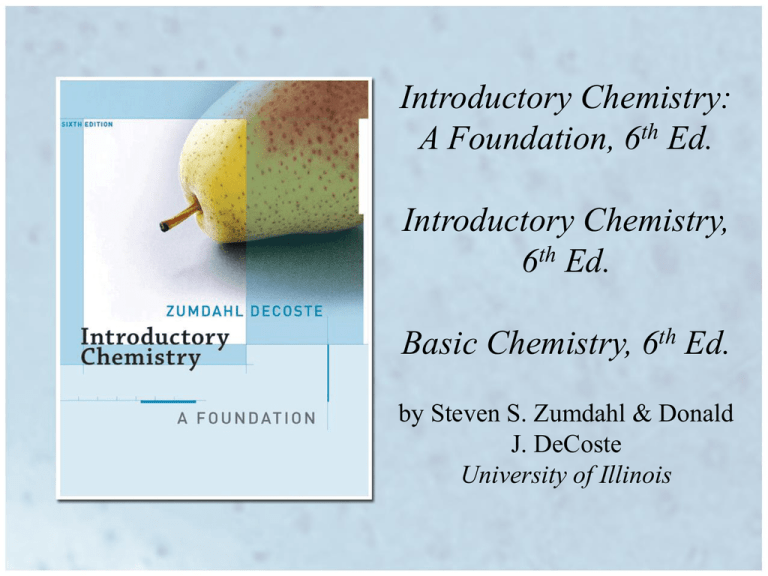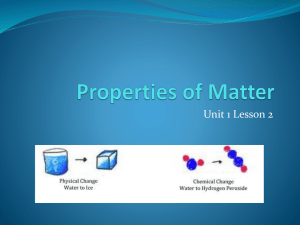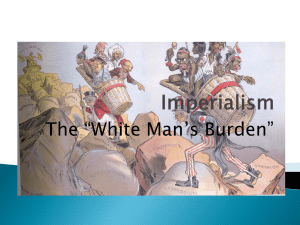
Introductory Chemistry:
A Foundation, 6th Ed.
Introductory Chemistry,
6th Ed.
Basic Chemistry, 6th Ed.
by Steven S. Zumdahl & Donald
J. DeCoste
University of Illinois
Chapter 10
Energy
Energy and Energy Changes
• Energy: ability to do work or produce heat
– Chemical, mechanical, thermal, electrical, radiant,
sound, nuclear
– Potential and kinetic
• Energy may affect matter.
– e.g. Raise its temperature, eventually causing a state
change, or cause a chemical change such as
decomposition
• All physical changes and chemical changes
involve energy changes.
Copyright © Houghton Mifflin Company. All rights reserved.
10 | 3
Energy and Energy Changes
• Potential Energy:
energy due to
composition or position
• Kinetic Energy: energy
due to motion
– - ½ mv2
Copyright © Houghton Mifflin Company. All rights reserved.
10 | 4
Energy and Energy Changes (cont.)
• Law of Conservation of Energy: energy can
be converted from one form to another, but
cannot be created or destroyed
Copyright © Houghton Mifflin Company. All rights reserved.
10 | 5
Work and Energy
• Work: force acting over a distance
– w=f•d
– Work done on a system will increase the
energy of the system, whereas work done by
the system will decrease the energy of the
system
• State function: a property that changes
independent of pathway
Copyright © Houghton Mifflin Company. All rights reserved.
10 | 6
Temperature and Heat
• Heat: a flow of energy due to a temperature
difference
• Temperature: a measure of the random
motions of the components of a substance
Copyright © Houghton Mifflin Company. All rights reserved.
10 | 7
Temperature and Heat (cont.)
Copyright © Houghton Mifflin Company. All rights reserved.
10 | 8
Exothermic vs. Endothermic
• System: that part of the universe that we wish to study
• Surroundings: everything else in the universe
• Exothermic process: is any process that gives off heat –
transfers thermal energy from the system to the surroundings.
Example: when a match is struck, it is an exothermic process
because energy is produced as heat. and 2H2 (g) + O2 (g)
2H2O (l) + energy
• Endothermic process: absorbs heat
-
Example: melting ice to form liquid water is an endothermic
process because the ice absorbs heat in order to melt energy +
H2O (s)
H2O (l)
Copyright © Houghton Mifflin Company. All rights reserved.
10 | 9
Exothermic Process
Copyright © Houghton Mifflin Company. All rights reserved.
10 | 10
Enthalpy (H) is used to quantify the heat flow into or out of
a system in a process that occurs at constant pressure.
DH = H (products) – H (reactants)
DH = heat given off or absorbed during a reaction at constant
pressure
Copyright © Houghton Mifflin Company. All rights reserved.
10 | 11
Thermochemical Equations
Is DH negative or positive?
System absorbs heat
Endothermic
DH > 0
6.01 kJ are absorbed for every 1 mole of ice that
melts at 00C and 1 atm.
H2O (s)
H2O (l)
Copyright © Houghton Mifflin Company. All rights reserved.
DH = 6.01 kJ
6.3
10 | 12
Thermochemical Equations
•
The stoichiometric coefficients always refer to the number
of moles of a substance
H2O (s)
•
DH = 6.01 kJ
If you reverse a reaction, the sign of DH changes
H2O (l)
•
H2O (l)
H2O (s)
DH = -6.01 kJ
If you multiply both sides of the equation by a factor n,
then DH must change by the same factor n.
2H2O (s)
2H2O (l)
Copyright © Houghton Mifflin Company. All rights reserved.
DH = 2 x 6.01 = 12.0 kJ
10 | 13
Thermochemical Equations
•
The physical states of all reactants and products must be
specified in thermochemical equations.
H2O (s)
H2O (l)
DH = 6.01 kJ
H2O (l)
H2O (g)
DH = 44.0 kJ
How much heat is evolved when 266 g of white
phosphorus (P4) burn in air?
P4 (s) + 5O2 (g)
266 g P4 x
P4O10 (s)
1 mol P4
123.9 g P4
x
Copyright © Houghton Mifflin Company. All rights reserved.
DH = -3013 kJ
3013 kJ
= 6470 kJ
1 mol P4
10 | 14
Different enthalpies
• Heat of reaction (DHr or DHrxn)- heat energy absorbed
or released during a reaction.
• Heat of formation (DHf)- heat energy absorbed or
released during synthesis of one mole of a compound
from its elements at 298 K and 1 atm pressure (STPstandard temp and pressure).
• Heat of solution (DHsol)- heat energy absorbed or
released when a substance dissolves in a solvent.
• Heat of combustion (DHcomb)- heat energy released
when a substance reacts with oxygen to form CO2 and
H2O.
Copyright © Houghton Mifflin Company. All rights reserved.
10 | 15
• Heat of fusion (DHfus)= Energy needed to melt one
mole (solid to liquid)
• Heat of vaporization (DHvap)=Energy needed to boil
one mole (liquid to gas)
• In a phase change graph, it is possible to calculate the
total energy involved as well as the energy consumed
in each step.
• Note that water has different values for sp. heat
depending upon its physical state.
Copyright © Houghton Mifflin Company. All rights reserved.
10 | 16
Thermodynamics
• The Law of Conservation of Energy is also known
as The First Law of Thermodynamics. It can be
stated as “the energy of the universe is constant.”
• Internal Energy (E) = kinetic energy + potential
energy
• ΔE = q + w = change in internal energy
q = heat absorbed by the system
w = work done on the system
Copyright © Houghton Mifflin Company. All rights reserved.
10 | 17
Units of Energy
• One calorie = amount of energy needed to
raise the temperature of one gram of water by
1°C
– kcal = energy needed to raise the temperature of
1000 g of water 1°C
• joule
– 4.184 J = 1 cal
• In nutrition, calories are capitalized.
– 1 Cal = 1 kcal
Copyright © Houghton Mifflin Company. All rights reserved.
10 | 18
Example - Converting Calories to Joules
Convert 60.1 cal to
joules.
Copyright © Houghton Mifflin Company. All rights reserved.
10 | 19
Energy & Temperature of Matter
• The amount the temperature of an object increases
depends on the amount of heat added (q).
– If you double the added heat energy the temperature
will increase twice as much.
• The amount the temperature of an object increases
when heat is added depends on its mass
– If you double the mass it will take twice as much heat
energy to raise the temperature the same amount.
Copyright © Houghton Mifflin Company. All rights reserved.
10 | 20
Specific Heat Capacity
• Specific heat (s): the amount of energy
required to raise the temperature of one
gram of a substance by one degree Celsius
Amount of Heat = Specific Heat x Mass x Temperature Change
Q = s x m x DT
Copyright © Houghton Mifflin Company. All rights reserved.
10 | 21
Specific Heat Capacity
Copyright © Houghton Mifflin Company. All rights reserved.
10 | 22
Example #1:
Calculate the amount of heat energy (in joules)
needed to raise the temperature of 7.40 g of
water from 29.0°C to 46.0°C.
Copyright © Houghton Mifflin Company. All rights reserved.
10 | 23
Example #1 (cont.)
Specific heat of water = 4.184
J
g C
Mass = 7.40 g
Temperature change = 46.0°C – 29.0°C = 17.0°C
Q = s • m • DT
Copyright © Houghton Mifflin Company. All rights reserved.
10 | 24
Example #2
A 1.6 g sample of metal that appears to be
gold requires 5.8 J to raise the temperature
from 23°C to 41°C. Is the metal pure gold?
Copyright © Houghton Mifflin Company. All rights reserved.
10 | 25
Example #2
Table 10.1 lists the specific heat of gold as 0.13
Therefore the metal cannot be pure gold.
Copyright © Houghton Mifflin Company. All rights reserved.
10 | 26
Enthalpy
• Change in enthalpy (ΔHp = qp): the amount
of heat exchanged when heat exchange
occurs under conditions of constant pressure
• Enthalpy is a state function
• ΔH is independent of the path taken
Copyright © Houghton Mifflin Company. All rights reserved.
10 | 27
Hess’s Law
• Hess’s Law: in going from a set of reactants to
a set of products, the change in enthalpy is the
same whether the reaction takes place in one
step or in a series of steps.
Copyright © Houghton Mifflin Company. All rights reserved.
10 | 28
Hess’ Law (cont.)
• ΔHreaction= ∑Δhsteps
• If the direction of a reaction is reversed, the
sign of ΔH is reversed.
• ΔHforward = -Δhreverse
• Magnitude of ΔH α quantities of reactants
and products
Copyright © Houghton Mifflin Company. All rights reserved.
10 | 29
Hess’s Law (cont.)
• Overall reaction:
N2 + 2O2
2NO2 ΔH = 68 kJ
• This reaction can be carried out in 2 steps:
N2 + O2
2NO
ΔH = 180 kJ
2NO + O2
2NO2
ΔH = -112 kJ
-------------------------------------------------------N2 + 2O2
2NO2
ΔH = 68 Kj
Note: the sum of the two reactions gives the overall
reaction and the same is true for the sum of the
enthalpy change values.
Copyright © Houghton Mifflin Company. All rights reserved.
10 | 30
Calorimetry
• The amount of heat flow transferred during a
reaction is determined from temperature
measurements made in a calorimeter.
• Heat loss is minimized by having insulation. A
simple calorimeter can be made in the lab by
stacking 2 styrofoam cups. A calorimeter
minimizes heat exchange between the system and
the surroundings.
• Amount of heat produced is calculated by
measuring the temp change in the surrounding
water.
• DH=D t (H20) X mH2O XCpH2O
Copyright © Houghton Mifflin Company. All rights reserved.
10 | 31
Calorimetry (cont.)
Copyright © Houghton Mifflin Company. All rights reserved.
10 | 32
Energy Quality & Quantity
• While the total amount or quantity of energy
in the universe is constant (1st Law) the
quality of energy is degraded as it is used.
Burning of petroleum:
High grade concentrated energy
energy (heat)
Copyright © Houghton Mifflin Company. All rights reserved.
Low grade
10 | 33
Fuels
• Petroleum
– A fossil fuel composed mainly of hydrocarbons
• Natural gas
– Consists largely of methane
– Also contains ethane, propane, and butane
Copyright © Houghton Mifflin Company. All rights reserved.
10 | 34
Fuels (cont.)
Copyright © Houghton Mifflin Company. All rights reserved.
10 | 35
Fuels (cont.)
Copyright © Houghton Mifflin Company. All rights reserved.
10 | 36
Fuels (cont.)
• Coal
– Matures geologically through stages
Copyright © Houghton Mifflin Company. All rights reserved.
10 | 37
Global Warming
Copyright © Houghton Mifflin Company. All rights reserved.
10 | 38
Global Warming (cont.)
Copyright © Houghton Mifflin Company. All rights reserved.
10 | 39
Energy Use and Sources
Copyright © Houghton Mifflin Company. All rights reserved.
10 | 40
Energy as a Driving Force
• Most processes that occur spontaneously
involve an “energy spread.”
– Heat flows from high to low temperature and
“spreads”
…or a “matter spread”
– Salt dissolves or “spreads” in water
Copyright © Houghton Mifflin Company. All rights reserved.
10 | 41
Entropy
• Entropy (S) is a measure of disorder or randomness.
– As a system becomes more disordered, ΔS >0
• Second Law of Thermodynamics: the entropy of the
universe is always increasing.
• Tendency in nature is to increase disorder
(unless external forces counteract). Ex—messy
room, throwing a puzzle
• -Entropy in solids< liquids<gases
Copyright © Houghton Mifflin Company. All rights reserved.
10 | 42
• Entropy=S (absolute Entropy for a substance=Entropy
at absolute zero temp -273K). Units J/K.mol
• - change in Entropy= DS
• DS=Sproducts-Sreactants
– - Entropy can be the driving force behind
reactions. Ex- reactions leading to the formation of
gases (from solids) are favored.
– - Higher temp=higher Entropy (due to more KE of
particles)
– - Lower temp=lower Entropy (less KE)
– - Ideal conditions for a spontaneous reaction
• Increase Entropy (disorder)
• Decrease enthalpy of products
Copyright © Houghton Mifflin Company. All rights reserved.
10 | 43
•-
Reactions can thus occur even if not
entropically favored. Ex• 2H2 (g)+O2 (g) 2H2O (g)
• 3 molecules2 molecules (decrease in entropysame physical state)
• But reaction is highly exothermic (ie. Much
lower enthalpy of products)
Copyright © Houghton Mifflin Company. All rights reserved.
10 | 44







